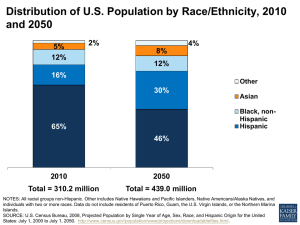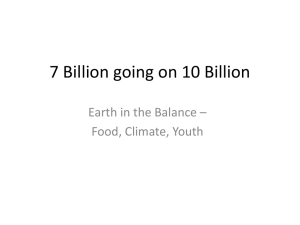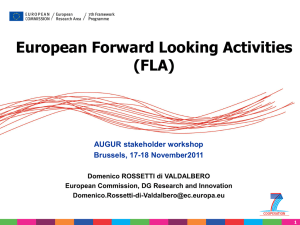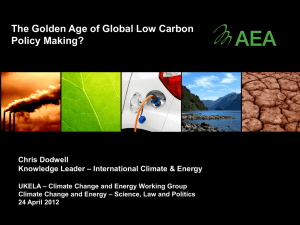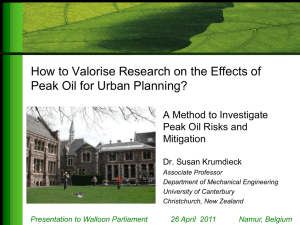Roadmap 2050
advertisement
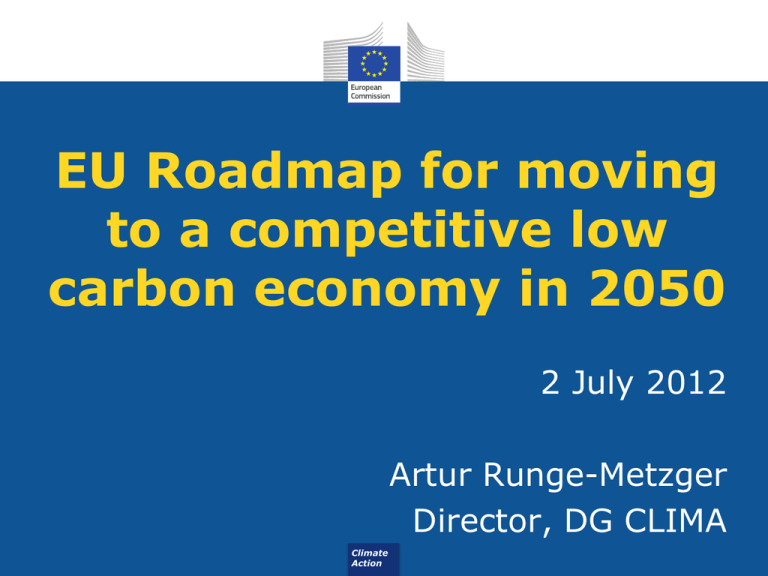
EU Roadmap for moving to a competitive low carbon economy in 2050 2 July 2012 Artur Runge-Metzger Director, DG CLIMA Climate Action Outline • Climate policy challenges • Where does the EU stand now? • Roadmap 2050 • Global analysis • EU analysis • Next steps Climate Action Limiting climate change – a global challenge Science requires that global emissions are cut by 50% by 2050 compared to 1990 EU objective of reducing greenhouse gas emissions by 80-95% by 2050 compared to 1990, in the context of necessary reductions by developed countries Need for a low carbon 2050 strategy providing the framework for the longer term action Need to fix intermediary stages towards reaching the 2050 objective Need to keep developments under review on a regular basis 3 Climate Action Climate change threatening future economic growth 2005 : US$ 228 billion 4 Climate Action Climate Action until 2020 5 Climate Action Where does the EU stand now? 150.0 140.0 130.0 120.0 GHG emissions Population Real GDP 110.0 Primary energy • EU emissions reduced by 15.5% 1990 -2010 • EU GDP grew 40% • EU on track towards 20% emission reduction by 2020 100.0 90.0 2006 2007 2008 2009 2010 2000 2001 2002 2003 2004 2005 1995 1996 1997 1998 1999 1990 1991 1992 1993 1994 80.0 6 Climate Action However, majority of Member States will not meet national non-ETS target in 2020 2020 projections 2020 national target 40% 30% 20% 10% 0% -10% -20% -30% HU UK NL SE PT FR DE FI ES EU DK CZ AT PO BG IT IE BE EE EL CY LU RO LV SI SK LT MT Current projections show the EU would meet its 2020 target. However, for 13 Member States, the existing policies would not be sufficient to reach their national target. 7 Climate Action Roadmap 2050: Global analysis 8 Climate Action 2050 Roadmap The first extensive global and EU analysis on how the long term target can be reached: • identifies cost-effective pathway, with intermediate milestones, • identifies key technologies guiding R&D, • identifies investments needs and benefits, • identifies opportunities and trade-offs, • guides EU, national and regional policies, • gives direction to private sector and private households for long term investments. 9 Climate Action The impact of climate action on the global temperature increase by 2100 Global emissions pathway in the next 40 years will determine likely warming by the end of the century 10 Climate Action Only global climate action reduces emissions in all parts of the world EU objective: 80 to 95% reductions largely through domestic measures: EU 100% around -80% internal reductions in 2050 compared to 1990 80% similar efforts 20% 60% 40% Developed Countries: 0% 1990 Developing Countries: 2000 500% 80% 400% 60% 300% 40% 200% 20% 100% 2000 2010 Baseline 2020 2030 Global action Climate Action 2030 2040 2050 2040 2050 Global action Developing Countries Developed Countries 100% 0% 1990 2020 Baseline -5% compared to 1990 Equivalent to - 80% compared to business as usual no cheap offsets by 2050 2010 2040 2050 0% 1990 2000 2010 Baseline 2020 2030 Global action 11 Global climate action leads to converging emissions per capita 12 Climate Action Global climate action reduces fossil fuel prices Oil price development 150 $ per barrel 125 100 75 50 25 0 2010 Baseline 2020 2030 Fragmented action 2040 2050 Global Action 13 Climate Action Global forestry and agriculture must be part of the solution • • • • Need to ensure food security to feed 9 billion people EU objective of eliminating net deforestation around 2030 Efforts to reduce agricultural emissions, or rather limit their increase Increased biomass use for energy as a result of global action on climate change 14 Climate Action Global agricultural productivity matters for future food prices 1. No yield improvement 2. Base case: Only 0.5% yield improvement for crops 3. Base case + also 0.5% yield improvement for livestock 15 Climate Action Roadmap 2050: EU analysis 16 Climate Action A cost-efficient pathway towards 2050 80% domestic reduction in 2050 is feasible 100% 100% Power Sector 80% with currently available 80% Current policy technologies, with behavioural Residential & Tertiary change only induced 60% through prices If all economic sectors Industry contribute to a varying 40% degree & pace. Efficient pathway: -25% in 2020 -40% in 2030 -60% in 2040 60% 40% Transport 20% 20% Non CO2 Agriculture Non CO2 Other Sectors 0% 1990 0% 2050 17 Climate Action 2000 2010 2020 2030 2040 Roadmap 2050: Energy efficiency will be key • Energy efficiency is the single most important contribution by 2050 • Also essential in the short term • Climate and energy package: 20% GHG reduction, 20% renewables and 20% energy efficiency improvement • Current policies only result in 10% energy efficiency improvement • Roadmap confirms key role of efficiency up to 2020 and beyond • Efforts towards 20% efficiency target would deliver 25% GHG reduction • ETS is one instrument to deliver additional efficiency 18 Climate Action Roadmap 2050: Investing in innovation … GDP and GHG decoupling 220 200 180 1990 = 100% Additional domestic investment: € 270 billion annually during 2010-2050, equivalent to 1.5% of GDP (Total investment – 19% of GDP in 2009), of which • built environment (buildings and appliances): € 75 billion • transport (vehicles and infrastructure): € 150 billion • power (electricity generation, grid): € 30 billion 160 140 120 100 80 60 40 1990 2000 GDP Climate Action 2010 2020 GHG emissions 2030 Roadmap 2050: … means saving energy, reducing energy bill and raising air quality & health • Fuel savings: € 175 to 320 billion on average annually during 2010-2050 • Primary energy consumption about 30% below 2005 without negatively affecting energy services • Making EU economy more energy secure: GDP and GHG decoupling 220 200 1990 = 100% 180 160 140 120 100 • Halves imports of oil and gas compared to today • Saving € 400 billion of EU oil and gas import bill in 2050, equivalent to > 3% of today’s GDP 80 60 40 1990 2000 GDP 2010 2020 2030 GHG emissions Climate Action • Air quality and health benefits: € 27 billion in 2030 and € 88 billion in 2050 Roadmap 2050: Creating new jobs in the EU • Where will new jobs come from? • Short term: e.g. in renovation of buildings, production of insulation materials, renewables industry • Potential net job creation up to 1.5 million by 2020 • Use auctioning revenues from EU emissions trading system and tax revenues for reduction of labour costs and increase in investments and R&D • Long term job prospects depend on favourable economic framework conditions, e.g. expenditure on research & technology development, innovation, entrepreneurship, new skills, investment 21 Climate Action Roadmap 2050: Making the EU fit for the global low-carbon race • All competitors develop their own low carbon strategies, e.g. • US: • 1 million electric cars on road by 2015 • 80% clean energy by 2035 • China: • Two-year investment plan: +0.8% GDP on innovation, restructuring, energy conservation, emissions reductions and ecological improvement • 12th 5-year plan (2011-2015): reducing emissions per unit of GDP by 17%, accelerating R&D and use of lowcarbon technologies, low-carbon pilot projects Climate Action EU’s policy challenges (1) • Ensure the achievement of 20% energy efficiency target by 2020, and in this context use the role of the emissions trading system • Give clarity for long term investments, especially in ETS sectors • Define 2020 - 2030 policy framework • Upward review of 1.74% linear reduction to be considered to achieve -80% GHG emissions by 2050 • Measures to protect vulnerable industries against carbon leakage in the case of fragmented action 23 Climate Action EU’s policy challenges (2) • Implement Strategic Energy Technology (SET) Plan (€ 50 billion from 2014-2020) • Develop innovative financing instruments to use limited public finance to leverage private sector investments in the next EU budget, e.g. in cohesion policy • Use CAP to contribute to further emission reductions and increased absorption of natural sinks, taking into account the increased demand for agricultural and 24 forestry products including for bio-energy Climate Action Next steps • Negotiation of EU Multi-annual Financial Framework and detailed legislation for individual spending programmes. • Further Commission analysis of cost efficient and equitable mix of individual policy instruments and implications for individual Member States. • Member States to develop long-term national and regional low emission development strategies. 25 Climate Action For further information: http://ec.europa.eu/clima/ policies/brief/eu/index_en.htm 26 Climate Action
